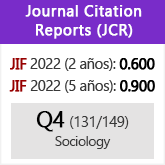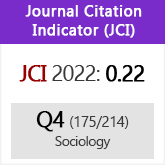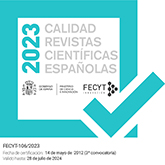Los determinantes socioeconómicos de la desigualdad económica. Datos de Portugal
DOI:
https://doi.org/10.3989/ris.2008.10.24Palabras clave:
Desigualdad, Distribución de la renta, Distribución salarial, Distribución de las rentas de capital, modelo Probit ordenado generalizadoResumen
Este artículo utiliza el Panel de Hogares de la Unión Europea (1994-2001) para investigar cuáles son los determinantes socioeconómicos de la desigualdad. el artículo se centra en Portugal, el país de la Unión Europea con mayores niveles de desigualdad, para documentar hechos relevantes sobre las distribuciones de la renta, salarios y rentas de capital. se muestra cómo estas distribuciones están relacionadas con características familiares tales como edad, educación, estado civil y estado laboral. Por último, se emplea un modelo Probit ordenado generalizado para investigar cómo y en qué medida las diferentes características socio-económicas de las familias determinan su estatus económico y su movilidad a lo largo de las distribuciones. el artículo concluye que la educación es, con diferencia, la dimensión socioeconómica más determinante en relación con la desigualdad.
Descargas
Citas
Altonji, J and R. Blank. 1999. “Race and Gender in the Labor Market”. In Ashenfelter, Orley and D. Card, eds., Handbook of Labor Economics, pp. 3143–3259. North-Holland: Amsterdam.
Antonovics, K. and R. Town. 2004. “Are All the Good Men Married? Uncovering the Sources of the Marital Wage Premium”. American Economic Review. 2: 317-321.
Asplund, R. and E. Barth. 2005. Education and Wage Inequality in Europe: A Literature Review. The Research Institute of the Finnish Economy ETLA. Helsinki. Series B209.
Atkinson A.B. 1970. “On the measurement of inequality”. Journal of Economic Theory. 2: 244-263.
Atkinson, A.B. 1971. “The Distribution of Wealth and the Individual Life-cycle”. Oxford Economic Papers. 23: 239-254.
Atkinson, A.B. and F. Bourguignon. 2000. Handbook of Income Distribution. vol 1, Elsevier Science, B.V.: Amsterdam.
Bourguignon F., M. Fournier and M. Gurgand. 2005. “Distribution, Development and Education in Taiwan, China, 1979-94”. In F. Bourguignon, Ferreira and N. Lustig, eds., The Microeconomics of Income Distribution Dynamics. pp. Oxford: World Bank and Oxford University Press.
Brooks, C. and J. Manza. 2006a. “Social Policy Responsiveness in Developed Democracies”. American Sociological Review. 71: 474-494.
Brooks, C. and J. Manza. 2006b. “Why Do Welfare States Persist?”. Journal of Politics. 68: 816-827.
Budría, S., J. Díaz-Giménez, J.V. Ríos-Rull and V. Quadrini. 2002. “Updated Facts on the U.S. Distributions of Earnings, Income, and Wealth”. Quarterly Review of the Federal Reserve Bank of Minneapolis. 26: 1-35.
Budría, S. and J. Díaz-Giménez. 2007. “Economic inequality in Spain: The European Union Household Panel Dataset”. Spanish Economic Review. 9: 1-38.
Cardoso, A.R. 1998. “Earnings Inequality in Portugal: High and Rising?”. Review of Income and Wealth. 44: 325-343.
Cardoso, A.R. 2006. “Wage Mobility: Do Institutions Make a Difference? A Replication Study Comparing Portugal and the UK”. Labour Economics. 13: 387-404.
Cardoso, F. and V. Cunha. 2005. Household wealth in Portugal: 1980-2004. Banc of Portugal: Working Paper 4.
Carneiro, P. 2008. “Equality of Opportunity and Educational Achievement in Portugal”. Portuguese Economic Journal. 7: 17-41.
Castañeda, A., J. Díaz-Giménez and J.V. Ríos-Rull. 2002. “Accounting for earnings and wealth inequality”. Journal of Political Economy. 111: 818-857.
Chun, H. and I. Lee. 2001. “Why Do Married Men Earn More: Productivity or Marriage Selection?”. Economic Inquiry. 39: 307-19.
Cubbedu, L. and J.V Ríos-Rull. 2003. “Family as shocks”. Journal of the European Economic Association. 1: 671-682.
Deaton, A.S. and M.G. Kenward. 1998. “Ageing and Inequality in Income and Health”. American Economic Review Papers and Proceedings. 88: 248-253.
Deaton, A. and C. Paxson. 1994. “Intertemporal Choice and Inequality”. The Journal of Political Economy. 102: 437-467.
Deaton, A. and C. Paxson. 2001. “Mortality, Education, Income and Inequality Among American Cohorts”. In D. Wise ed. Themes in the Economics of Aging. pp 129-170. Chicago: University of Chicago Press.
Efron, B. and R.J. Tibshirani. 1993. An Introduction to the Bootstrap. New York: Chapman & Hall.
Eurostat. 1996. The European community household panel: survey methodology and implementation. 1. Luxembourg Office for Official Publications of the European Communities.
Gentry, W. and R. Hubbard. 2004. “Entrepreneurship and Household Saving”. Advances in Economic Analysis & Policy. 4: 1053-1053.
Gottschalk, P. and T. Smeeding. 2000. “Empirical Evidence on Income Inequality in Industrial Countries”. In A.B. Atkinson y F. Bourguignon, eds., Handbook of income distribution. Amsterdam: Elsevier.
Gouveia, M. and J. Tavares 1995. “The Distribution of Household Income and Expenditure in Portugal: 1980 and 1990”. Review of Income and Wealth. 41: 1-17.
Gouveia, M. and C.F. Rodrigues. 2002. “The Impact of a Guaranteed Minimum Income Program in Portugal”. Public Finance and Management. 2.
Hartog, J., P. Pereira and J.A. Vieira. 2001. “Changing Returns to Education in Portugal during the 1980s and Early 1990s: OLS and Quantile Regression Estimators”. Applied Economics. 33: 1021-1037.
Jenkins, S. 1991. “The Measurement of Income Inequality”. In L. Osberg, ed., Economic Inequality and Poverty: International Perspectives. New York: Armonk.
Kaplow, L. 2005. “Why Measure Inequality?”. Journal of Economic Inequality. 3: 65-79.
Machado, J. and J. Mata. 2001. “Earning Functions in Portugal 1982-1994: Evidence from Quantile Regressions”. Empirical Economics. 26: 115-134.
Martins, P.S. and P.T Pereira 2004. “Does Education Reduce Wage Inequality? Quantile Regressions Evidence from Fifteen European Countries”. Labour Economics. 11: 355-371.
Peracchi, F. 2002. “The European Community Household Panel: A Review”. Empirical Economics. 27: 63–90.
Quadrini, V. 2000. “Entrepreneurship, Saving, and Social Mobility”. Review of Economic Dynamics. 3: 1-40.
Rodrigues, C.F. 1999. “Repartição do Rendimento e Pobreza em Portugal [1994/95] - Uma Comparação entre o Painel de Agregados Familiares e o Inquérito aos Orçamentos Familiares Income distribution and Poverty in Portugal [1994/95] - A Comparison between the European Community Household Panel and the Household Budget Survey”. Revista de Estatística. 10: 117-142.
Shorrocks, A. 1978. “The Measurement of Mobility”. Econometrica. 46: 1013-1024.
Silber, J. 1999. Handbook of Income Inequality Measurement. Boston: Kluwer Academic Publishers.
Vieira, J.C, J.P. Couto and M.T. Tiago 2005. Inter-Regional Wage Dispersion in Portugal. IZA Discussion Paper 1664.
Zaidi A, J. Frick and F. Buechel. 2005. “Income dynamics within retirement in Great Britain and Germany”. Ageing and Society. 25: 543–565.
Zaidi, A. and B. Gustafsson. 2007. “Income mobility among the elderly in Sweden during the 1990s”. International Journal of Social Welfare. 16: 84-93.
Descargas
Publicado
Cómo citar
Número
Sección
Licencia
Derechos de autor 2010 Consejo Superior de Investigaciones Científicas (CSIC)

Esta obra está bajo una licencia internacional Creative Commons Atribución 4.0.
© CSIC. Los originales publicados en las ediciones impresa y electrónica de esta Revista son propiedad del Consejo Superior de Investigaciones Científicas, siendo necesario citar la procedencia en cualquier reproducción parcial o total.Salvo indicación contraria, todos los contenidos de la edición electrónica se distribuyen bajo una licencia de uso y distribución “Creative Commons Reconocimiento 4.0 Internacional ” (CC BY 4.0). Puede consultar desde aquí la versión informativa y el texto legal de la licencia. Esta circunstancia ha de hacerse constar expresamente de esta forma cuando sea necesario.
No se autoriza el depósito en repositorios, páginas web personales o similares de cualquier otra versión distinta a la publicada por el editor.

















